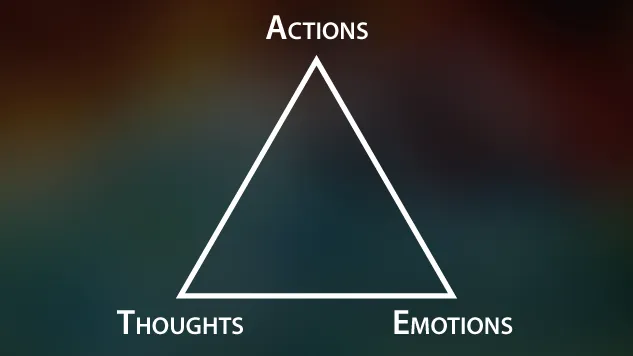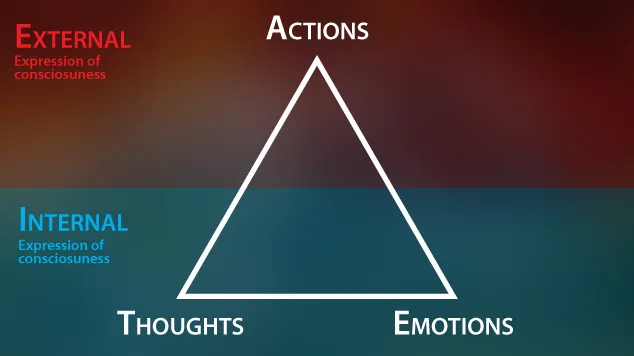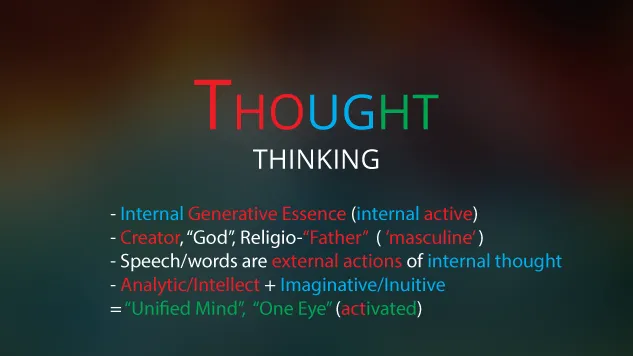Our consciousness perceives objects, events and phenomena in the external existence we all share. It can also perceive things in the mind’s eye, in imagination, which only exist in the internal existence that is unique to each of us.
Thoughts and emotions feedback -- as internal expressions of consciousness -- to process information from our environment which acts upon us as a stimulus. Our thoughts and emotions combine to produce our actions, the external expressions of consciousness.

This is the trinity of consciousness. To be united in consciousness requires that we think, feel and act in harmony, to be in alignment and integrity among our own manifestations of consciousness. As we think, we also feel in alignment with that thought or thinking, and act in accordance.
Colors have symbolic meaning. I use the colors in this way:
- Blue represents internal or receptive/passive and therefore feminine.
- Red represents external or active and therefore masculine.
- Green represents the unification or activated states, such as from uniting the internal blue and external red.
Something can have multiple contextual applications of color to symbolize different qualities.

Thoughts and emotions are both internal expressions of consciousness. They form the base of the trinity that culminates into action. Action is the external expression. The internal base is more symbolic of the feminine compared to the masculine symbolism of actions.
The upright triangle itself symbolizes the masculine, a pointed object, which is related to phallic symbolism. A downward triangle, on the other hand, is used to symbolize the feminine. Since the triangle is positioned on its base, it encompasses the goal of action at the top as the end goal. In order for things to be accomplished in life, action is required.
Thoughts
Thoughts are where it all starts. They are the initial generator of other manifestations of consciousness. Thoughts are also part of our internal unseen realm that is unique to each individual. No one else can see your thought if they remain unexpressed as spoken or written words.
Words that are spoken or written are an action. This also makes thought the first active state within us. They are also active in the sense that they can produce emotional states. Merely thinking of things can make you feel a certain way without any external stimulus acting upon you.
Anxiety or panic attacks can be created by simply thinking of things, things that don’t exist yet or may never happen to you. We can make ourselves sick just by the power of thought to act upon our physiology. There is also the placebo effect, where thoughts can create physiological changes as well.
Thoughts are red for their active symbolism, and blue as they are internal, but they are also green as they can be a unification of the left and right brain modalities of consciousness which are not in opposition.
When our thoughts are not contradictory, when we have integrated a coherent and cohesive understanding of reality, when our “left” (red) and “right” (blue) brained modalities of consciousness are not in opposition, but are harmonized in unison (green), then we have the symbolism of a “unified mind” or “one eye” (unified left and right) present for that particular task or function we are engaged in at the time.
This is an activated state that can be deactivated or non-active. We could be unified at one moment, yet divided another. Our state of consciousness isn’t constant. Things can happen to destabilize us and it takes self-control to realign our expressions of consciousness.
The green “unified mind” or “one eye” symbolism is an activated state, formed through a synthesis of our analytical and intellectual left-brain capacities, holistically integrated with our imaginative and intuitive right-brain capacities. For example, our intuition may conclude one thing, and the analytical thinking another. Upon further reflection and analysis, the original analysis may have been flawed, or the intuition was, but we move forward unified.
We can recognize reality as it is, and also envision new things that can be created. They may not yet exist, but we can work to create them. This first requires us to think about them, to generate them in our consciousness. We can also envision alternative better ways to be and live and create those as a way of life and living.
Thoughts are our internal cognition, the generative essence that starts everything. As such, it is both internal, but also active in that it is the active generative essence and force that gets the ball rolling.
Since this is the activated and therefore masculine symbolism, this relates to the religious symbolism of a source generative essence for creating, represented as the father or male figure (masculine, red). This is “God” the creator in the Christian Trinity. We, consciousness, are the “gods” that affect, manifest, generate and create into reality. We are all creators in some way or another and in varying degrees, and the symbolism is used to represent who we are.
Even before we get to physical action with our hands to create things in the world like a fork or spoon, we are able to express our internal thoughts through speech and words which are external actions (red).

